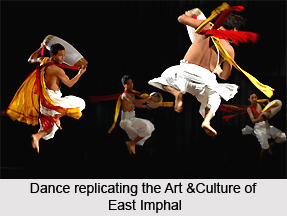 Art and Culture of Imphal East District that falls within the ambit of Manipur have been identifying itself to the world exhibiting the confluence of the ancient tradition with the modern. Manipur portrays a mosaic of traditions and culture patterns. Manipuri classical dance is world famous and it is very generally distinct from other Indian dance forms. Ras Lila, the very face of classical dance that devours its nourishment from the spiritual and eternal love of Radha and Lord Krishna.
Art and Culture of Imphal East District that falls within the ambit of Manipur have been identifying itself to the world exhibiting the confluence of the ancient tradition with the modern. Manipur portrays a mosaic of traditions and culture patterns. Manipuri classical dance is world famous and it is very generally distinct from other Indian dance forms. Ras Lila, the very face of classical dance that devours its nourishment from the spiritual and eternal love of Radha and Lord Krishna.
Rash Dance
As an obvious result their sublime and transcendental love and the selfless devotion of the milkmaids of Vrindavan to the Lord. The dance is performed in the "Mandap" in front of the temple all through the night and witnessed with great dedication and care. Rash performances are mainly of four types-Vasanta Rash, Kunja Rash, Maha Rash and Nata/Nitya Rash. Within the premises of Shri Shri Govinda, Vasanta Ras is performed on the full-moon night of Hiyangei (November). After a certain moment when the rituals are completed at the temple of Shri Shri Govinda, they are performed at any time of the year. Based on Tenth Book of the Bhagavata, Maha Rash and Vasanta Rash are performed on Geet Govinda of Jayadeva. A fifth type called Diva Ras is occasionally met with Ras Lila is a combination of solo, duet and grace. It is the richness of the costumes that provide lustre to the overall artistic proliferation of the programme.
Pung Cholom
Pung Cholom comes from the term Pung that is a kind of Manipur drum. Khuyoi Tompok who ruled over Manipur during (154-264 A.D) introduced the pung having only one beating face. Since then, it has developed to the present form of `Meitei Pung with two beating faces. This Pung has become a part and parcel of Nata Sankirtan which is an important part of Manipuri culture. Today, `Pung Cholom` which is a traditional dance form of the pung drummers has earned international acclamation for its charming artistic display.
Pena
Pena is a stringed musical instrument of Manipur. Its origin may be traced back to a hoary past. It is called Bena in Parts of Assam. It is made up of two parts viz the penamasa and pena cheijing. Earlier, Pena was usually played by its player to invoke the gods and goddesses. But today, this musical instrument is played in musical concerts and other performances also.
Khongjom Parva
Khongjom Parva is a musical narration of the Battle of Khongjom fought between the Manipuris and the British in April 1891.Dhobi Leinou started singing Khongjom Parva by thumping his hands on the knee and some times used an empty tin to thump upon. The Khongjom Parva narrators glorify the Manipuris soldiers who sacrificed their lives for the sake of their motherland. Today the theme of singing Khongjom Parva includes the stories of Khamba and Thoibi, the Ramayana, the Mahabharata and the exploits of the kings of Manipur. The singer uses only a Dholok while singing.
Wari Liba
Wari Liba is an indigenous art form of telling stories prevalent in the State since the 17th century. The Mahabharata and the Ramayan are the themes of such story telling. Manipuri folk song is known as `Khulang Ishei`. It is popular for its thematic and romantic contents. The folk songs are commonly sung by the rural folk and hill men at the time of harvesting, collecting firewood, hunting and fishing.



















